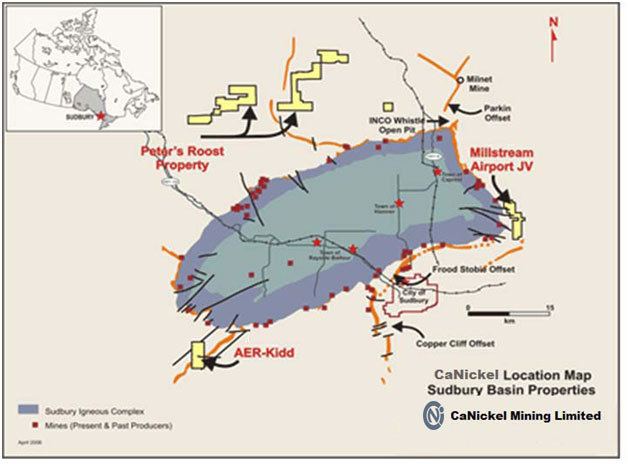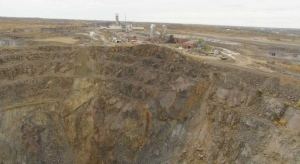 | ||
Similar Lake Wanapitei, Gosses Bluff crater, Meteor Crater, Ramsey Lake, Inco Superstack | ||
The Sudbury Basin, also known as Sudbury Structure or the Sudbury Nickel Irruptive, is a major geological structure in Ontario, Canada. It is the second-largest known impact crater or astrobleme on Earth, as well as one of the oldest.
Contents

The basin is located on the Canadian Shield in the city of Greater Sudbury, Ontario. The former municipalities of Rayside-Balfour, Valley East and Capreol lie within the Sudbury Basin, which is referred to locally as "The Valley". The urban core of the former city of Sudbury lies on the southern outskirts of the basin.

The Sudbury Basin is located near a number of other geological structures, including the Temagami Magnetic Anomaly, the Lake Wanapitei impact crater, the western end of the Ottawa-Bonnechere Graben, the Grenville Front Tectonic Zone and the eastern end of the Great Lakes Tectonic Zone, although none of the structures are directly related to each other in the sense of resulting from the same geological processes.

Cool science the sudbury basin rocks
Formation

The Sudbury basin formed as a result of an impact into the Nuna supercontinent from a bolide approximately 10–15 km (6.2–9.3 mi) in diameter that occurred 1,849 million years ago in the Paleoproterozoic era.

Debris from the impact was scattered over an area of 1,600,000 km2 (620,000 sq mi) thrown more than 800 km (500 mi); rock fragments ejected by the impact have been found as far as Minnesota.

Models suggest that for such a large impact, debris was most likely scattered globally, but has since been eroded away. Its present size is believed to be a smaller portion of a 250 km (160 mi) round crater that the bolide originally created. Subsequent geological processes have deformed the crater into the current smaller oval shape. Sudbury Basin is the second-largest crater on Earth, after the 300 km (190 mi) Vredefort crater in South Africa, and larger than the 180 km (110 mi) Chicxulub crater in Yucatán, Mexico.
Structure
The full extent of the Sudbury Basin is 62 km (39 mi) long, 30 km (19 mi) wide and 15 km (9.3 mi) deep, although the modern ground surface is much shallower.
The main units characterizing the Sudbury Structure can be subdivided into three groups: the Sudbury Igneous Complex (SIC), the Whitewater Group, and footwall brecciated country rocks that include offset dikes and the Sub layer. The SIC is believed to be a stratified impact melt sheet composed from the base up of sub layer norite, mafic norite, felsic norite, quartz gabbro, and granophyre.
The Whitewater Group consists of a suevite and sedimentary package composed of the Onaping (fallback breccias), Onwatin, and Chelmsford Formations in stratigraphic succession. Footwall rocks, associated with the impact event, consist of Sudbury Breccia (pseudotachylite), footwall breccia, radial and concentric quartz dioritic breccia dikes (polymict impact melt breccias), and the discontinuous sub layer.
Because considerable erosion has occurred since the Sudbury event, an estimated 6 km (3.7 mi) in the North Range, it is difficult to directly constrain the actual size of the Sudbury crater, whether it being the diameter of the original transient cavity, or the final rim diameter.
The deformation of the Sudbury structure occurred in five main deformation events (by age in Mega years):
- formation of the Sudbury Igneous Complex (1849 Ma)
- the Penokean orogeny (1890–1830 Ma)
- the Mazatzal orogeny (1700–1600 Ma)
- the Grenville orogeny (1400–1000 Ma)
- the Lake Wanapitei impact (37 Ma)
Disputes over origin
Some 1.8 billion years of weathering and deformation made it difficult to prove that a meteor was the cause of the Sudbury geological structures. A further difficulty in proving that the Sudbury complex was formed by meteor impact rather than by ordinary igneous processes was that the region was volcanically active at around the same time as the impact, and some weathered volcanic structures can look like meteor collision structures. Since its discovery, a layer of breccia has been found associated with the impact event and stressed rock formations have been fully mapped.
Geologists reached consensus by about 1970 that the Sudbury basin was formed by a meteor impact. Reports published in the late 1960s described geological features that were said to be distinctive of meteor impact, including shatter cones and shock-deformed quartz crystals in the underlying rock. In 2014, analysis of the concentration and distribution of siderophile elements as well as the size of the area where the impact melted the rock indicated that a comet rather than an asteroid most likely caused the crater.
Modern uses
The large impact crater filled with magma containing nickel, copper, platinum, palladium, gold, and other metals. In 1856 while surveying a baseline westward from Lake Nipissing, provincial land surveyor Albert Salter located magnetic abnormalities in the area that were strongly suggestive of mineral deposits. The area was then examined by Alexander Murray of the Geological Survey of Canada, who confirmed "the presence of an immense mass of magnetic trap".
Due to the then-remoteness of the Sudbury area, Salter's discovery did not have much immediate impact. The later construction of the Canadian Pacific Railway through the area, however, made mineral exploration more feasible. The development of a mining settlement occurred in 1883 after earth moving at the railway construction site revealed a large concentration of nickel and copper ore at what is now the Murray Mine site.
As a result of these metal deposits, the Sudbury area is one of the world's major mining communities. The region is one of the world's largest suppliers of nickel and copper ores. Most of these mineral deposits are found on the outer rim of the basin.
Due to the high mineral content of its soil, the floor of the basin is among the best agricultural land in Northern Ontario, with numerous vegetable, berry, and dairy farms located in the valley. However because of its northern latitude, it is not as productive as agricultural lands in the southern portion of the province. Accordingly, the region primarily supplies products for consumption within Northern Ontario, and is not a major food exporter.
An Ontario Historical Plaque was erected by the province to commemorate the discovery of the Sudbury Basin.
